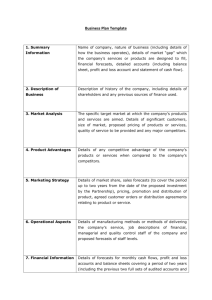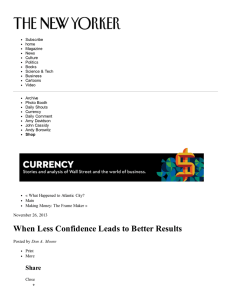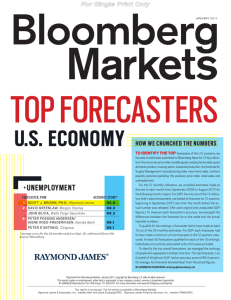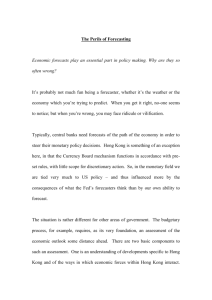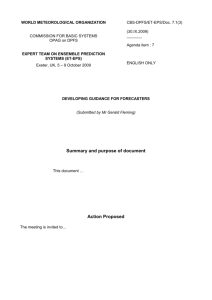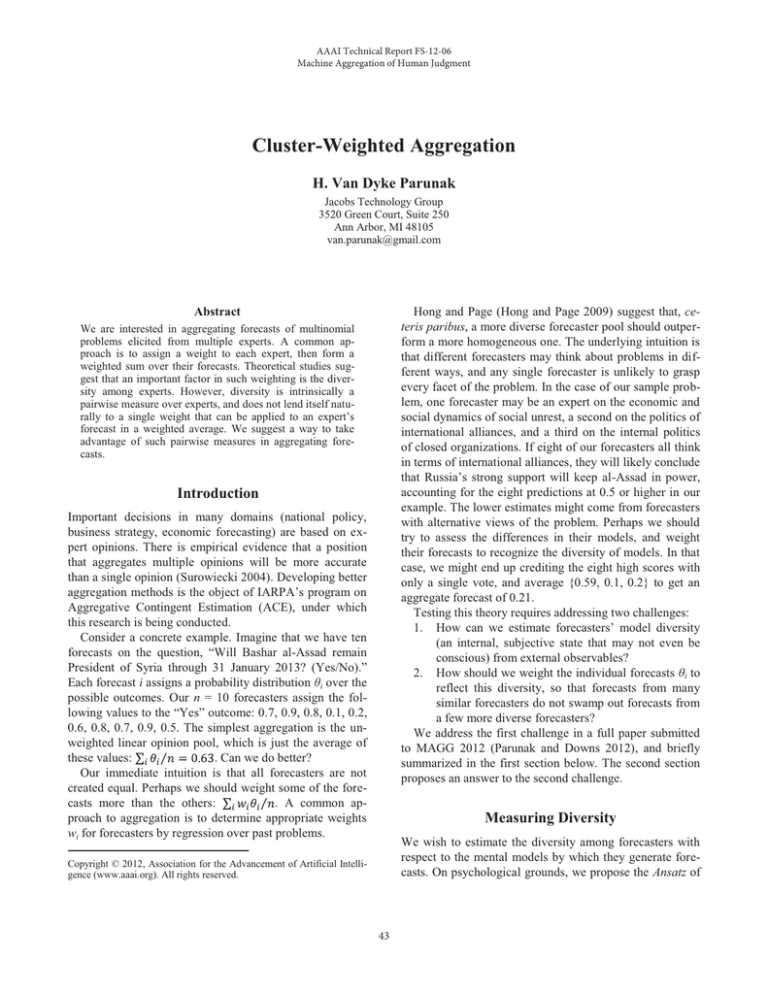
AAAI Technical Report FS-12-06
Machine Aggregation of Human Judgment
Cluster-Weighted Aggregation
H. Van Dyke Parunak
Jacobs Technology Group
3520 Green Court, Suite 250
Ann Arbor, MI 48105
van.parunak@gmail.com
Hong and Page (Hong and Page 2009) suggest that, ceteris paribus, a more diverse forecaster pool should outperform a more homogeneous one. The underlying intuition is
that different forecasters may think about problems in different ways, and any single forecaster is unlikely to grasp
every facet of the problem. In the case of our sample problem, one forecaster may be an expert on the economic and
social dynamics of social unrest, a second on the politics of
international alliances, and a third on the internal politics
of closed organizations. If eight of our forecasters all think
in terms of international alliances, they will likely conclude
that Russia’s strong support will keep al-Assad in power,
accounting for the eight predictions at 0.5 or higher in our
example. The lower estimates might come from forecasters
with alternative views of the problem. Perhaps we should
try to assess the differences in their models, and weight
their forecasts to recognize the diversity of models. In that
case, we might end up crediting the eight high scores with
only a single vote, and average {0.59, 0.1, 0.2} to get an
aggregate forecast of 0.21.
Testing this theory requires addressing two challenges:
1. How can we estimate forecasters’ model diversity
(an internal, subjective state that may not even be
conscious) from external observables?
2. How should we weight the individual forecasts θi to
reflect this diversity, so that forecasts from many
similar forecasters do not swamp out forecasts from
a few more diverse forecasters?
We address the first challenge in a full paper submitted
to MAGG 2012 (Parunak and Downs 2012), and briefly
summarized in the first section below. The second section
proposes an answer to the second challenge.
Abstract
We are interested in aggregating forecasts of multinomial
problems elicited from multiple experts. A common approach is to assign a weight to each expert, then form a
weighted sum over their forecasts. Theoretical studies suggest that an important factor in such weighting is the diversity among experts. However, diversity is intrinsically a
pairwise measure over experts, and does not lend itself naturally to a single weight that can be applied to an expert’s
forecast in a weighted average. We suggest a way to take
advantage of such pairwise measures in aggregating forecasts.
Introduction
Important decisions in many domains (national policy,
business strategy, economic forecasting) are based on expert opinions. There is empirical evidence that a position
that aggregates multiple opinions will be more accurate
than a single opinion (Surowiecki 2004). Developing better
aggregation methods is the object of IARPA’s program on
Aggregative Contingent Estimation (ACE), under which
this research is being conducted.
Consider a concrete example. Imagine that we have ten
forecasts on the question, “Will Bashar al-Assad remain
President of Syria through 31 January 2013? (Yes/No).”
Each forecast i assigns a probability distribution θi over the
possible outcomes. Our n = 10 forecasters assign the following values to the “Yes” outcome: 0.7, 0.9, 0.8, 0.1, 0.2,
0.6, 0.8, 0.7, 0.9, 0.5. The simplest aggregation is the unweighted linear opinion pool, which is just the average of
these values:
. Can we do better?
Our immediate intuition is that all forecasters are not
created equal. Perhaps we should weight some of the forecasts more than the others:
. A common approach to aggregation is to determine appropriate weights
wi for forecasters by regression over past problems.
Measuring Diversity
We wish to estimate the diversity among forecasters with
respect to the mental models by which they generate forecasts. On psychological grounds, we propose the Ansatz of
Copyright © 2012, Association for the Advancement of Artificial Intelligence (www.aaai.org). All rights reserved.
43
Since γij is symmetrical, we can define
last equation becomes
a Narrative Generator (NG), a set of statements about the
world (as in a Bayesian network) with weighted transitions
among them (as in a Markov network). How can we measure how similar the NGs of various forecasters are? Here
are several options (Parunak and Downs 2012).
1. Given a forecaster’s responses to an IFP, we can fit
transition weights to a skeleton NG generated by
SMEs, and use the resulting vector of weights to
characterize the forecaster.
2. We can look at differences in the temporal correlation of forecasts with world events that align with
statements in the NG, or more generally with the
IFP.
3. We can look at differences in forecasters’ responses
to the IFP in question, as well as to other IFPs.
4. We can look at which IFPs forecasters elect to answer.
All of these indicators give some evidence of a forecaster’s internal model, and can be used to derive a measure of
diversity among forecasters.
, and the
Of the possible ways to compute wij and thus cij, we have
been experimenting on the third measure of diversity, a
normalized and symmetrized delta divergence between
forecasts (Parunak and Downs 2012). Applied to the final
forecasts from 77 IFPs from the IARPA ACE program, this
algorithm gives a lift of only 2.5%.
This approach reduces our pairwise measures to a single
user diversity for each forecast, averaged over all other
users, and thus throws away information contained in the
pairwise numbers. How can we take advantage of this information in aggregation?
One approach is hierarchical clustering, which works in
the following way:
1. Define a pairwise distance between all entities.
2. Find the “closest” two entities, remove them, and
replace them with a new entity. Different methods
for estimating closeness yield different clustering
algorithms. Ties are broken randomly; alternatively,
methods exist (Fernández and Gómez 2008) to
combine more than two entities at a level, when all
of their pairwise distances are the same.
3. Find the pairwise distances between this new entity
and all the remaining entities. Again, different ways
of estimating this distance yield different clustering
algorithms.
4. While more than one entity remains, go to 2.
Figure 1 shows a dendrogram of forecasters clustered by
a measure of their diversity (in this case, cij + wij). This
display reflects rich structure among the forecasters. Some
cluster together at very low distance (toward the right),
while others merge only at higher distances (to the left).
We would like our weighting scheme to capture this rich
structure. In effect, we want to aggregate forecasts starting
at the leaves, and follow the tree structure until we reach
the root. Each cluster of forecasters corresponds to an aggregate forecast encompassing their individual forecasts,
appropriately weighted. By starting with pairwise measures
of forecaster separation, we can discount similar forecasts
from similar forecasters, and pay more attention to diverse
forecasters. We call this process “cluster-weighted aggregation,” CWA.1
Actually, CWA is a family of algorithms, with many different alternatives at each step (Parunak 2012). Our initial
implementation has the following features:
x We use cij + wij as the distance measure to form the
dendrogram.
Exploiting Diversity in Aggregation
Each of the measures above gives us an estimate of the
diversity δij of two forecasters i,j. All but the last can be
applied either to a single problem (the within-IFP diversity
wij) or across all IFPs (the cross-IFP diversity cij, naturally
computed as the average of wij over all IFPs on which both
i and j offer forecasts). The latter may be interpreted as an
indication of the overall similarity of two forecaster’s mental models. Of particular interest is the ratio of these quantities
where ζ is a small constant, 0.1 in our work, that avoids
singularities. γij ~1 indicates the unremarkable circumstance that similar models yield similar forecasts, and dissimilar models yield dissimilar ones. However, when γij >
1, dissimilar models are yielding similar forecasts, surely
meriting additional attention to their common estimates.
Conversely, γij < 1 indicates that even though forecasters
share a common model, they disagree on a given problem,
suggesting that their shared model offers no purchase on
this particular question, and encouraging us to discount
their forecasts. Thus γij recommends itself as a weight for
various forecasts. How shall we apply it?
Naively, we might use γij to weight forecasts in a linear
combination. Given forecasts θi, θj on a given IFP, it is
natural to suggest the aggregation
1
Pronounced like the French word “quoi,” colloquially used to mean
“really, in fact.”
44
x
x
x
We cluster using average linkage (Unweighted Pair
Group Method with Arithmetic Mean, or UPGMA)
We form the dendrogram completely before beginning aggregation.
We associate a mass with each forecast and each
cluster of forecasts.
Individual forecasts have a mass of 1.
The forecast of a cluster is given by
x
where θi and θj are the forecasts of the two items being clustered, and mi and mj are their weights
The weight assigned to the new cluster is
x
x
Applied to the final forecasts from 77 IFPs from the
ACE year 1 T&E program, this algorithm gives a lift of
17% with respect to ULinOP.
Conclusion
Some forecaster characteristics (notably, measures of diversity) are most naturally defined between pairs of forecasters. To support a conventional weighted average of
forecasts, the values for a single forecaster can be averaged
over the other forecasters with whom they are defined to
generate a single per-forecaster measure, but this process
discards the detailed pairwise information in the original
measure.
One way to exploit the pairwise information is to cluster
the forecasts hierarchically, and apply the pairwise features
at each level of the resulting cluster tree. One implementation of this approach (Cluster-Weighted Aggregation), applied to within-IFP and cross-IFP diversity measures, gives
significant gain over an averaged approach (17% vs. 2.5%
lift over ULinOP).
Figure 1: Dendrogram from Forecaster Pairwise Diversities
References
Fernández, A. and Gómez, S. 2008. "Solving Non-Uniqueness in
Agglomerative
Hierarchical
Clustering
Using
Multidendrograms." Journal of Classification 25: 43-65.
http://deim.urv.cat/~sgomez/papers/Fernandez-Solving_nonuniqueness_in_AHC_using_multidendrograms.pdf.
Hong, L. and Page, S. E. 2009. "Interpreted and Generated
Signals." Journal of Economic Theory 144: 2174-2196.
http://www.cscs.umich.edu/~spage/signals.pdf.
Acknowledgements
This research is supported by the Intelligence Advanced
Research Projects Activity (IARPA) via Department of
Interior National Business Center contract number
D11PC20060. The U.S. Government is authorized to reproduce and distribute reprints for Governmental purposes
notwithstanding any copyright annotation thereon. Disclaimer: The views and conclusions contained herein are
those of the authors and should not be interpreted as necessarily representing the official policies or endorsements,
either expressed or implied, of IARPA, Dol/NBC, or the
U.S. Government.
Parunak, H. V. D. 2012. Implementation Options for ClusterWeighted Aggregation. Ann Arbor, MI: Jacobs Technology.
Parunak, H. V. D. and Downs, E. 2012. Estimating Diversity
among Forecaster Models AAAI Fall Symposium: Machine
Aggregation of Human Judgment (MAGG 2012). Arlington, VA.
Surowiecki, J. 2004. The Wisdom of Crowds: Why the Many Are
Smarter Than the Few and How Collective Wisdom Shapes
Business, Economies, Societies and Nations. New York, NY:
Doubleday.
45


